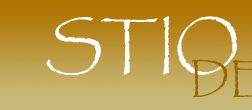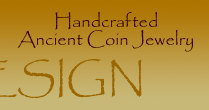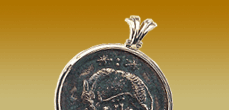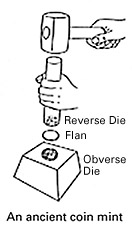







|
How Ancient Coins Were Minted
 A Greek or Roman mint was an unpretentious affair, and the whole operation would take up little space. The basic equipment included a small anvil, a pair of tongs, a brazier or charcoal fire, and a pair of leather bellows. A Greek or Roman mint was an unpretentious affair, and the whole operation would take up little space. The basic equipment included a small anvil, a pair of tongs, a brazier or charcoal fire, and a pair of leather bellows.The previously prepared circular or globular piece of metal, the "flan," was first heated to the softness required for receiving the impression of the dies. It was then placed by the tongs in the recess of the anvil which held the lower, or "obverse" die. The hand-held punch holding the reverse die, was now set over the flan and struck one or more blows with the hammer. Often the obverse side of the coin is a little rounded, and the reversed side, a little recessed. Being firmly set in an anvil, the "obverse" die gave the sharper impression, and so was used for the main "type." Moreover, the obverse die, being held so firmly in place and cushioned from the direct blow of the hammer, would outlast several of the hand-held reverse dies. The result is that there are many series of coins where the obverse die remains the same through several changes of reverse dies. The dies were made of malleable metal, usually bronze or soft iron. They were cut in intaglio, that is, the design was cut entirely below the surface, so that the die would yield an impression in relief. How the Jewelry is Made Each piece of jewelry is hand-crafted by Larry Gallo, owner and president of Stio Design. When a design is selected, Larry will guide you through the process of selecting a coin(s) to set in the piece. Each piece of jewelry is unique. The history and age of the coin and the custom craftsmanship will result in a treasured heirloom that is unmatched as a gift or family treasure. a |